Experimental Study of Damage Development in Salt Rock under Uniaxial Stress Using Ultrasonic Velocity and Acoustic Emissions
Abstract
:1. Introduction
2. Experimental Apparatus and Procedure
2.1. Experimental Apparatus
2.2. Test Sample
2.3. Test Procedures
3. Experimental Results
3.1. Deformation Features
3.2. Ultrasonic Wave Velocity
3.3. AE Activity
4. Rock Damage Recognition
4.1. Ultrasonic Velocity Ratio
4.2. Ib-Value
4.3. r-Value
5. Discussion
6. Conclusions
Acknowledgments
Author Contributions
Conflicts of Interest
References
- Berest, P.; Brouare, B.; Durup, G. Behavior of Sealed Solution-mined Cavern. In Proceedings of the EURock 96 on Performance in Rock Mechanics and Rock Engineering, Turin, Italy, 2–5 September 1996; pp. 1127–1131. [Google Scholar]
- Cosenza, P.H.; Ghoreychi, M.; Bazargan-Sabet, B.; Marsily, G.D. In situ rock salt permeability measurement for long term safety assessment of storage. Int. J. Rock Mech. Min. Sci. 1999, 24, 509–526. [Google Scholar] [CrossRef]
- Evans, D.J. An appraisal of underground gas storage technologies and incidents, for the development of risk assessment methodology. J. Fuel Cell Technol. 2007, 49, 97–107. [Google Scholar]
- Berest, P.; Brouard, B. Safety of salt caverns used for underground storage. Oil Gas Sci. Technol. 2003, 58, 361–384. [Google Scholar] [CrossRef]
- Thoms, R.L.; Gehle, R.M. A brief history of salt cavern use. In Proceedings of the 8th World Salt Symposium, The Hague, Netherlands, 7–11 May 2000; pp. 207–214. [Google Scholar]
- Neal, J.T.; Magorian, T.R. Geologic site characterization (GSC) principles derived from storage and mining projects in salt, with application to environmental surety. Environ. Geol. 1997, 29, 165–175. [Google Scholar] [CrossRef]
- Tomasko, D.; Elcock, D.; Veil, J.; Caudle, D. Risk Analyses for Disposing Nonhazardous Oil Field Wastes in Salt Caverns; Argonne National Laboratory: Lemont, IL, USA, 1997. [Google Scholar]
- Keeley, D. Failure Rates for Underground Gas Storage-Significance for Land Use Planning Assessments; Health and Safety Laboratory: Buxton, UK, 2008. [Google Scholar]
- Sovacool, B.K. The costs of failure: A preliminary assessment of major energy accidents, 1907–2007. Energy Policy 2008, 36, 1802–1820. [Google Scholar] [CrossRef]
- Dirtert, J.A.; Pursell, D.A. Underground Natural Gas Storage; Simmons & Company International: Houston, TX, USA, 2000. [Google Scholar]
- Whyatt, J.K.; Varley, F.D. Catastrophic failures of underground evaporate mines. In Proceedings of the 27th International Conference on Ground Control in Mining, Morgantown, WV, USA, 29–31 July 2008; pp. 113–122. [Google Scholar]
- Chmel, A.; Shcherbakov, I. A comparative acoustic emission study of compression and impact fracture in granite. Int. J. Rock Mech. Min. Sci. 2013, 64, 56–59. [Google Scholar] [CrossRef]
- Zhao, X.D.; Tang, C.A.; Li, Y.H.; Yuan, R.F.; Zhang, J.Y. Study on AE activity characteristics under uniaxial compression loading. Chin. J Rock Mech. Eng. 2006, 25, 3673–3678. [Google Scholar]
- Chen, S.W.; Yang, C.H.; Liu, P.J.; Wang, G.B.; Wei, X. Laboratory simulation test of thermal cracking of Beishan granite. Rock Soil Mech. 2016, 37, 547–556. [Google Scholar]
- Geng, J.S.; Sun, Q.; Zhang, Y.C.; Cao, L.W.; Zhang, W.Q. Studying the dynamic damage failure of concrete based on acoustic emission. Constr. Build Mater. 2017, 149, 9–16. [Google Scholar] [CrossRef]
- Kong, B.; Wang, E.Y.; Li, Z.H.; Wang, X.R.; Liu, X.F.; Li, N.; Yang, Y.L. Electromagnetic radiation characteristics and mechanical properties of deformed and fractured sandstone after high temperature treatment. Eng. Geol. 2016, 209, 82–92. [Google Scholar] [CrossRef]
- Li, B.Q.; Einstein, H.H. Comparison of Visual and Acoustic Emission Observations in a Four Point Bending Experiment on Barre Granite. Rock Mech. Rock Eng. 2017, 50, 2277–2296. [Google Scholar] [CrossRef]
- Alkan, H.; Cinar, Y.; Pusch, G. Rock salt dilatancy boundary from combined acoustic emission and triaxial compression tests. Int. J. Rock Mech. Min. Sci. 2007, 44, 108–119. [Google Scholar] [CrossRef]
- Ren, S.; Bai, Y.M.; Zhang, J.P.; Jiang, D.Y.; Yang, C.H. Experimental investigation of the fatigue properties of salt rock. Int. J. Rock Mech. Min. Sci. 2013, 64, 68–72. [Google Scholar]
- Fan, J.Y.; Chen, J.; Jiang, D.Y.; Chemenda, A.; Chen, J.C.; Ambre, J. Discontinuous cyclic loading tests of salt with acoustic emission monitoring. Int. J. Fatigue 2017, 94, 140–144. [Google Scholar] [CrossRef]
- Filimonov, Y.L.; Lavrov, A.V.; Shafarenko, Y.M.; Shkuratnik, V.L. Memory effects in rock salt under triaxial stress state and their use for stress measurement in a rock mass. Rock Mech. Rock Eng. 2001, 34, 275–291. [Google Scholar] [CrossRef]
- Szewczyk, D.; Bauer, A.; Holt, R.M. Stress-dependent elastic properties of shales—laboratory experiments at seismic and ultrasonic frequencies. Geophys. J. Int. 2017, 212, 189–210. [Google Scholar] [CrossRef]
- Luo, J.H.; Cai, Z.L.; Liu, K.; Li, X.C. Determination of the various stages in the process of rock failure under loading by the acoustic parameters. Rock Soil Mech. 1992, 13, 51–56. [Google Scholar]
- Zhu, J.X.; Chen, L.Z.; Yan, X.S. Ultrasonic pulses behavior in concrete during compressive loading. Eng. Mech. 1998, 15, 111–117. [Google Scholar]
- Zheng, G.P.; Zhao, X.D.; Liu, J.P.; Li, Y.H. Experimental study on change in acoustic wave velocity when rock is loading. J. Northeast. Univ. 2009, 30, 1197–1200. [Google Scholar]
- Asselmeyer, F.; Hartmann, K. Solidification of rock salt crystals by ultrasonic-waves. Phys. Status Solidi A–Appl. Mater. Sci. 1972, 14, 613–622. [Google Scholar] [CrossRef]
- Chen, J.; Ren, S.; Yang, C.H.; Jiang, D.Y.; Li, L. Self-healing characteristics of damaged Rock salt under different healing conditions. Materials 2013, 6, 3438–3450. [Google Scholar] [CrossRef] [PubMed]
- Zong, J.J.; Stewart, R.R.; Dyaur, N.; Myers, M.T. Elastic properties of rock salt: Laboratory measurements and Gulf of Mexico well-log analysis. Geophysics 2017, 82, 303–317. [Google Scholar] [CrossRef]
- Wang, B.; Zhu, J.B.; Yan, P.; Huang, S.L.; Wu, A.Q. Damage strength determination of marble and its parameters evaluation based on damage control test. Chin. J. Rock Mech. Eng. 2012, 31, 3967–3973. [Google Scholar]
- Li, L.; Chen, J.; Jiang, D.Y.; Yang, C.H.; Liu, C. Analysis of surface crack growth in layered salt rock under uniaxial compression. Rock Soil Mech. 2011, 32, 1394–1398. [Google Scholar]
- Wang, X.Q.; Ge, H.K.; Song, L.L.; He, T.M.; Xin, W. Experimental study of two types of rock sample acoustic emission events and Kaiser effect point recognition approach. Chin. J. Rock Mech. Eng. 2011, 30, 580–588. [Google Scholar]
- Gutenberg, B.; Richter, C.F. Seismicity of the Earth and Associated Phenomena, 2nd ed.; Princeton University Press: Princeton, NJ, USA, 1954. [Google Scholar]
- Rao, M.V.M.S.; Lakshmi, K.J.P. Analysis of b-value and improved b-value of acoustic emissions accompanying rock fracture. Curr. Sci. 2005, 89, 1577–1582. [Google Scholar]
- Zang, A.; Wanger, F.C.; Dresen, G. Acoustic emission, microstructure, and damage model of dry and wet sandstone stressed to failure. J. Geophys. Res. 1996, 101, 17507–17521. [Google Scholar] [CrossRef]
- Li, H.R.; Yang, C.H.; Chen, F.; Hong-Ling, M.A.; Wu, S.W. Development of a device for rock’ acoustic waves and acoustic emission integrative testing and its application. Rock Soil Mech. 2016, 37, 287–296. [Google Scholar]
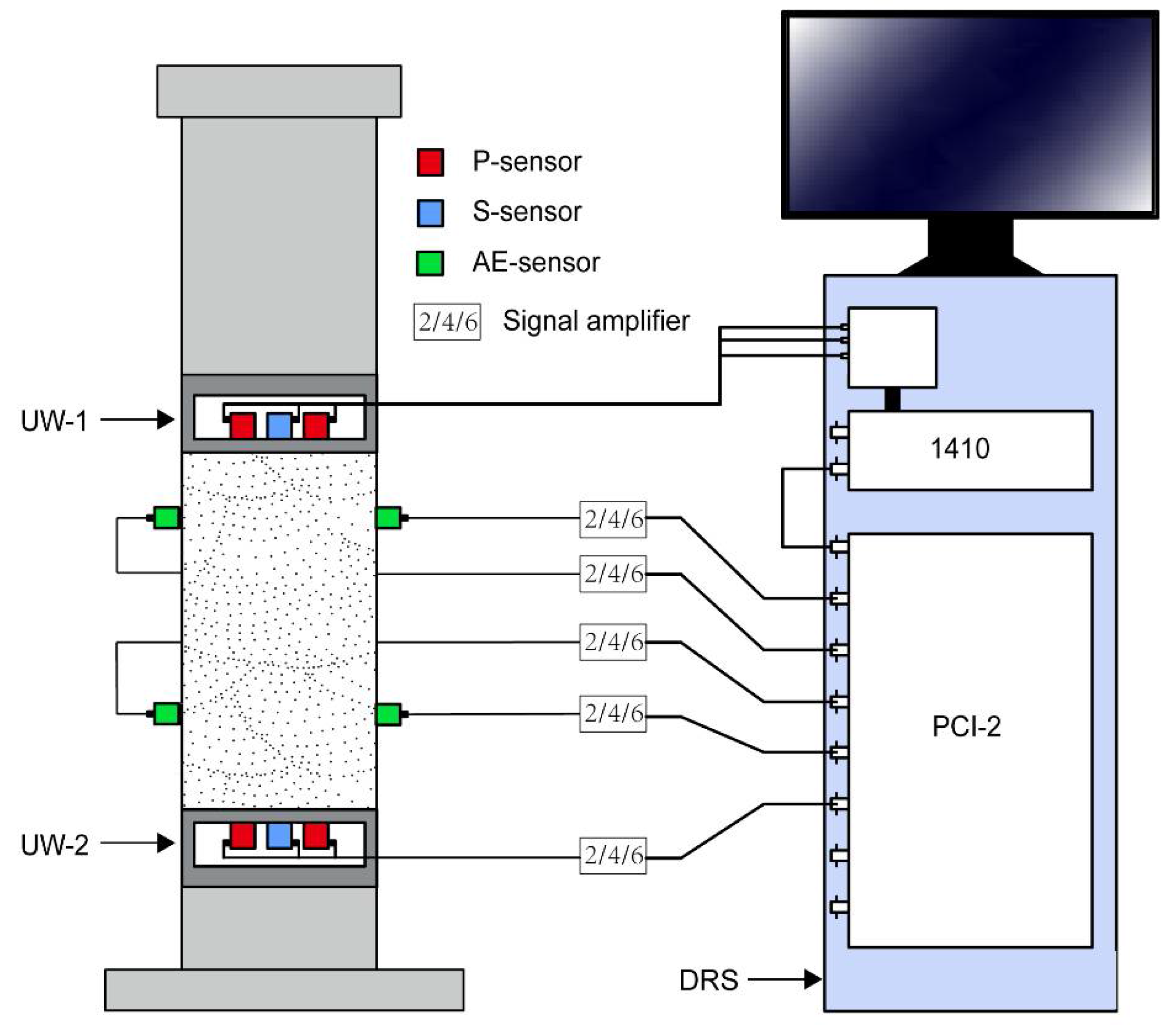
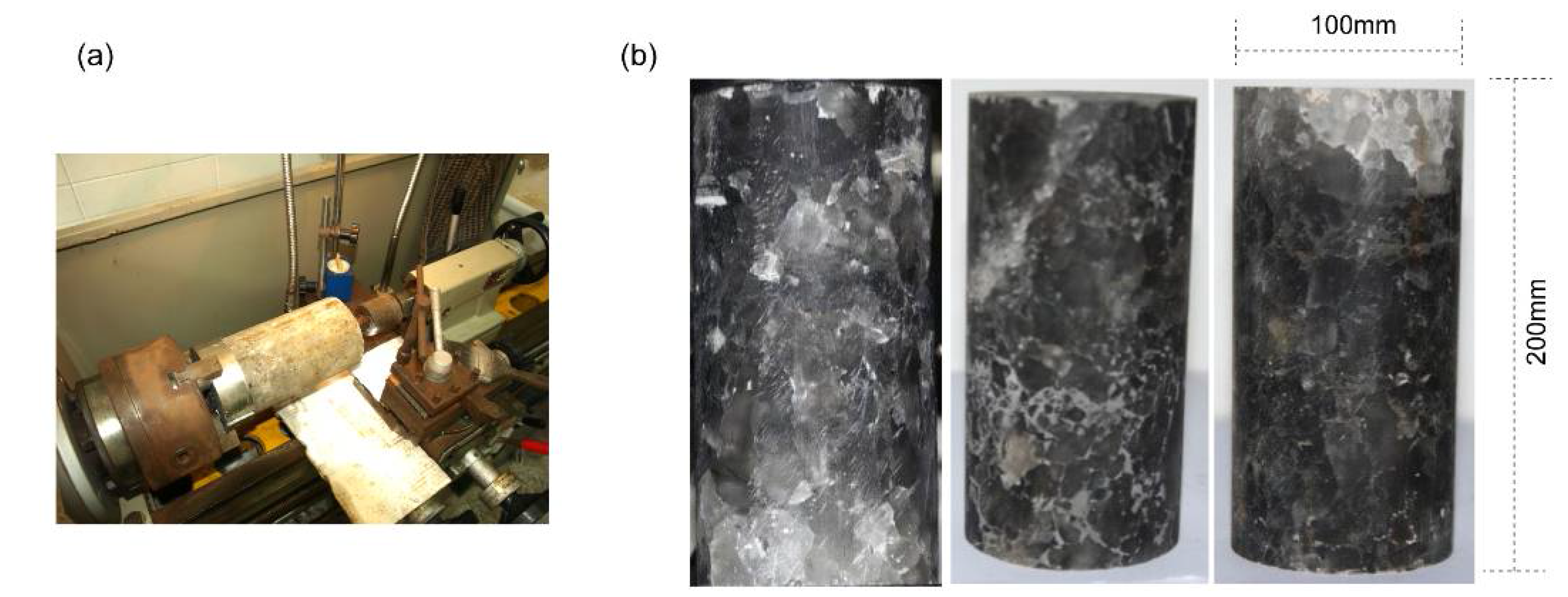
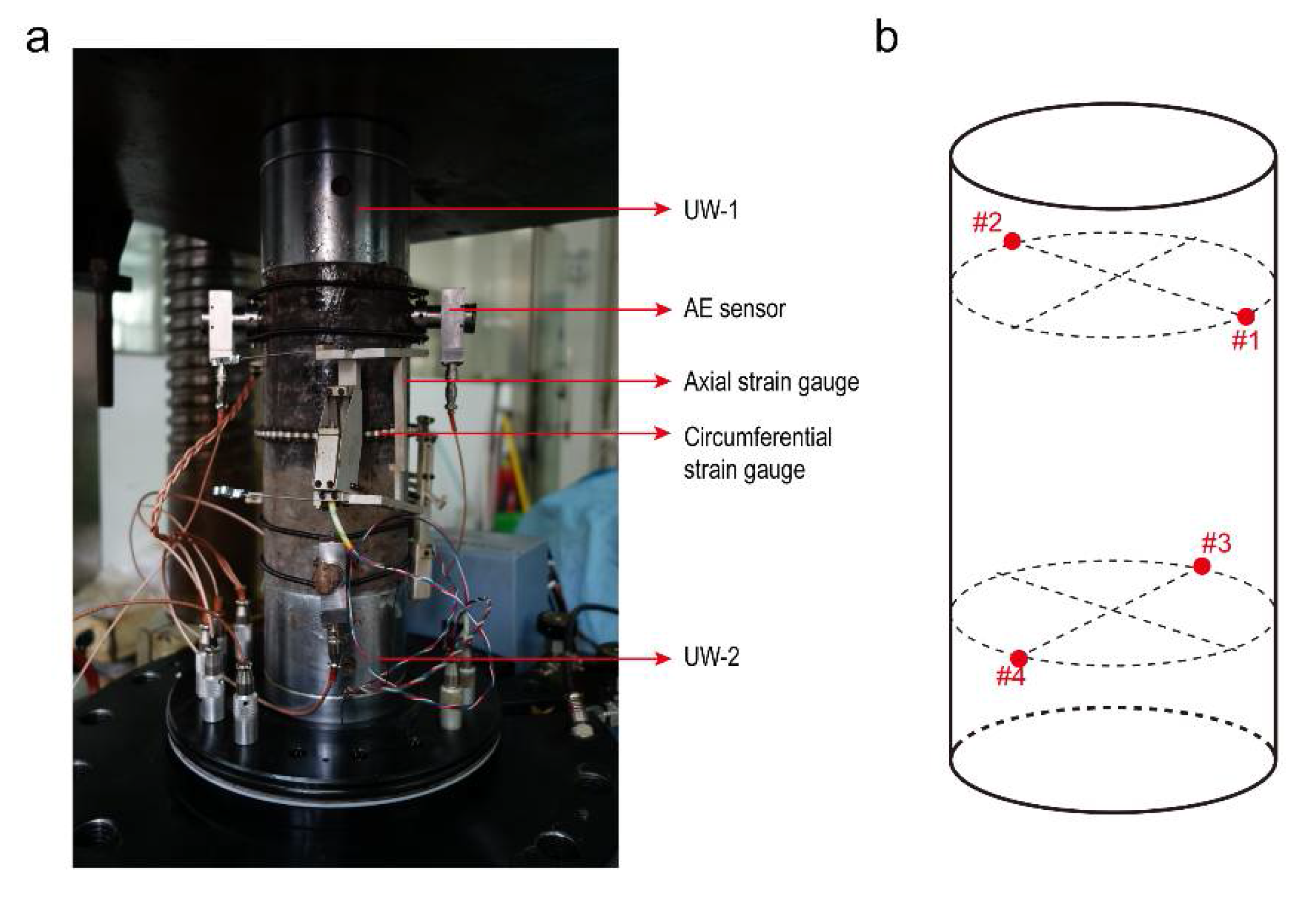
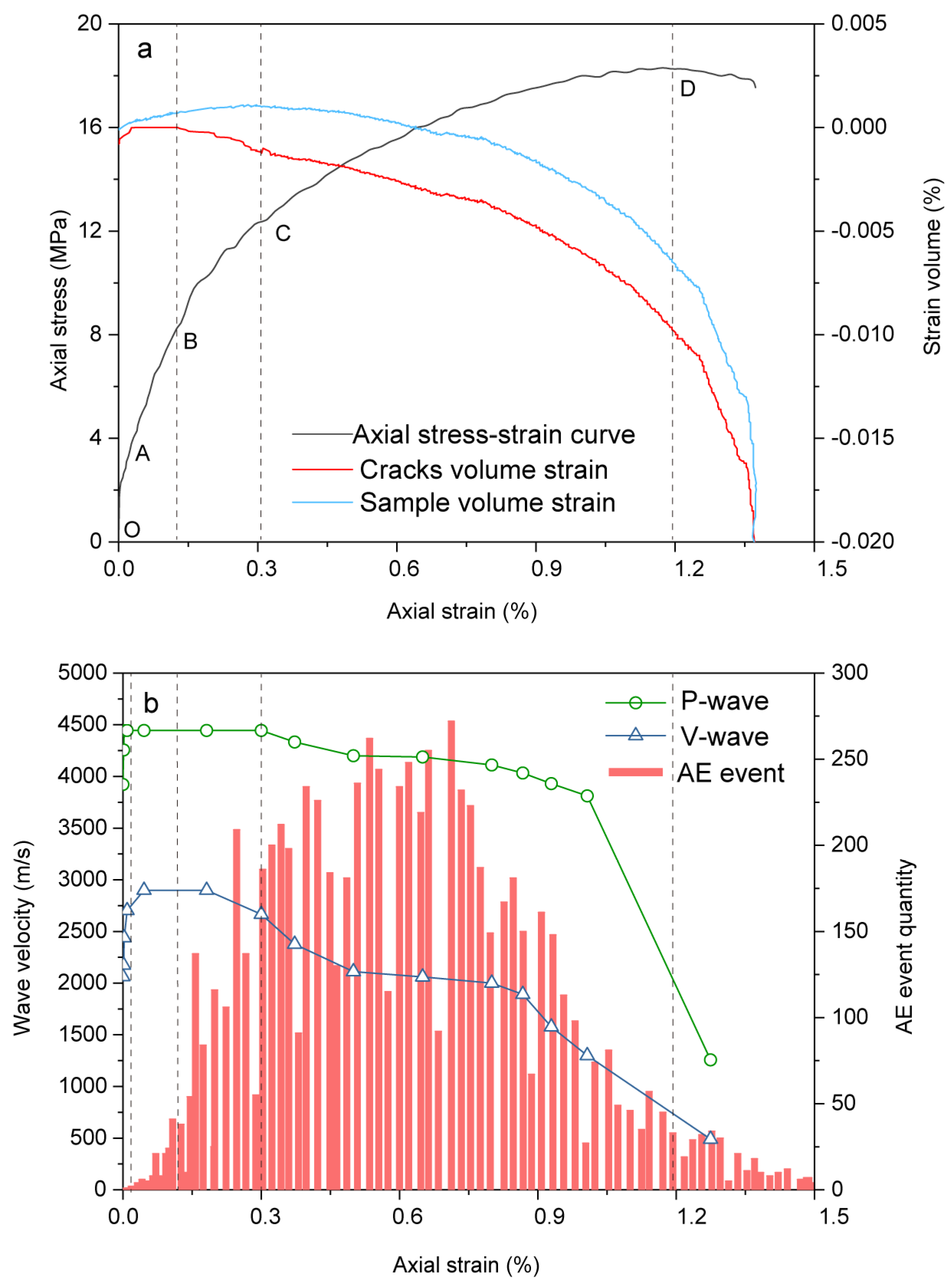
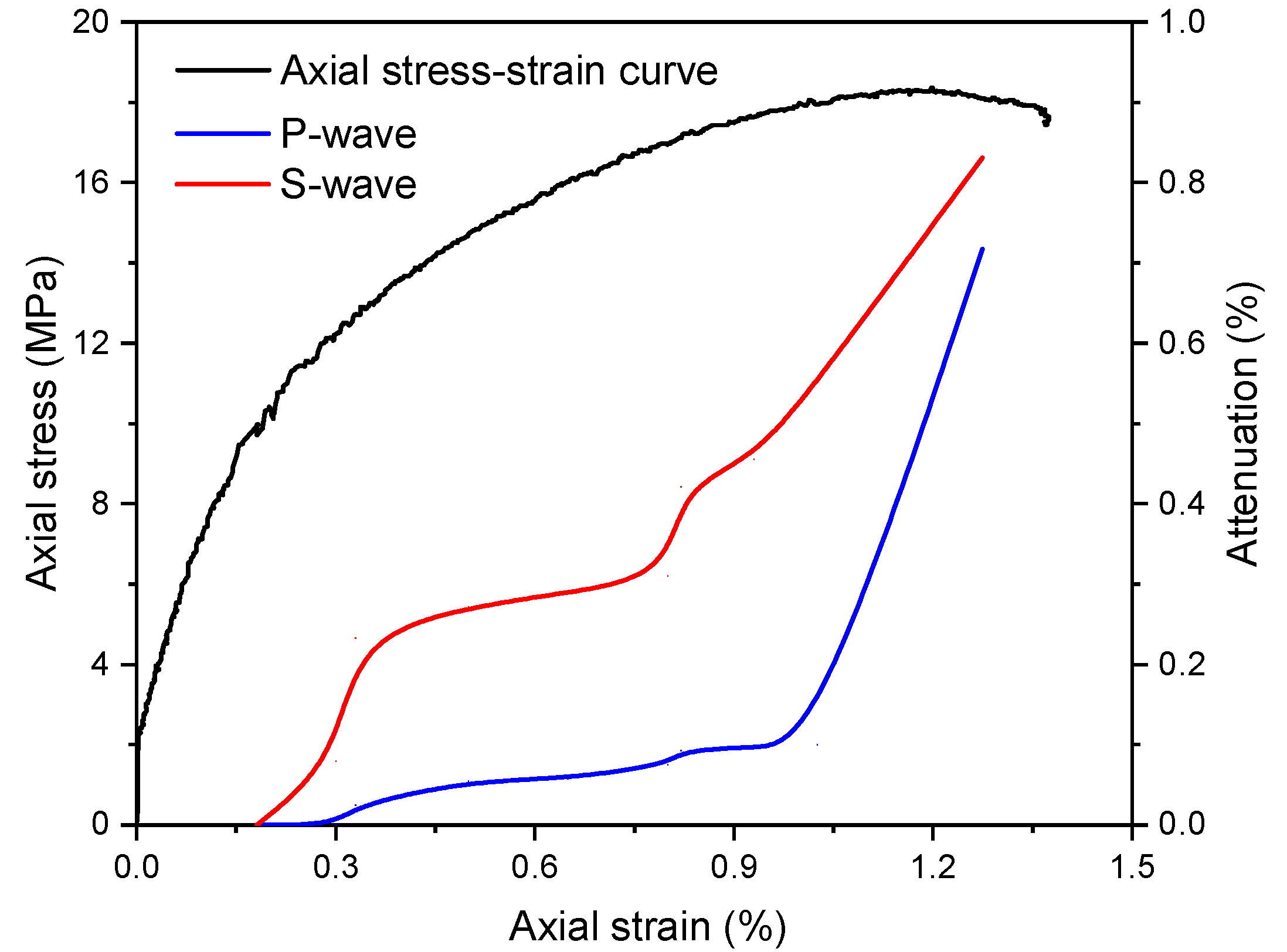

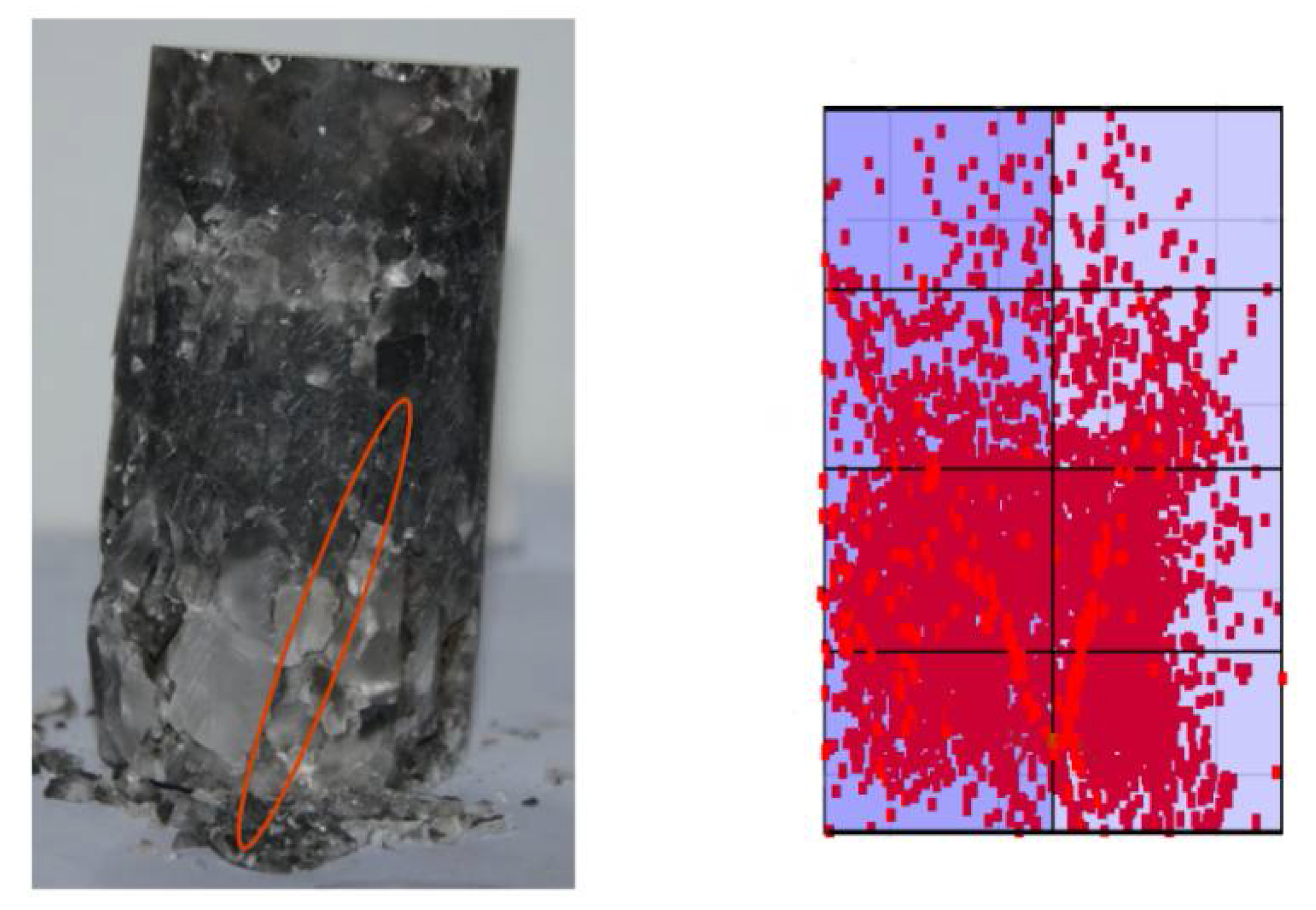

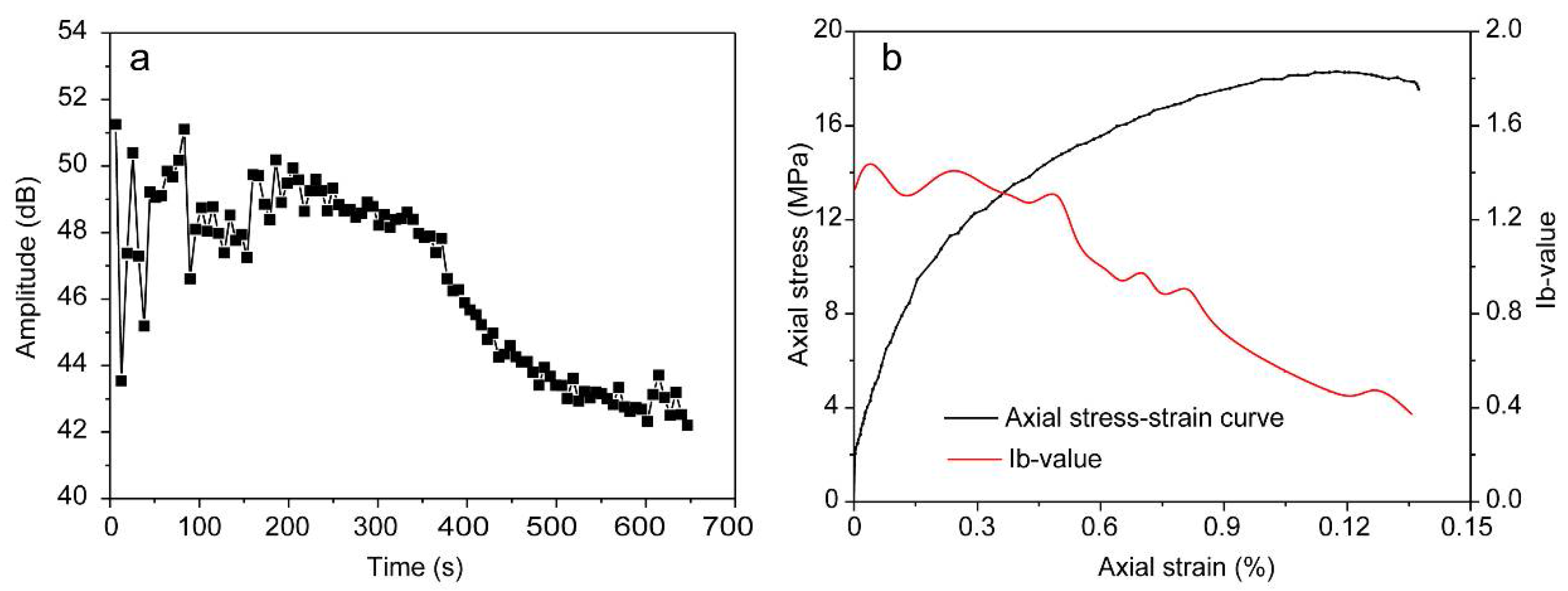
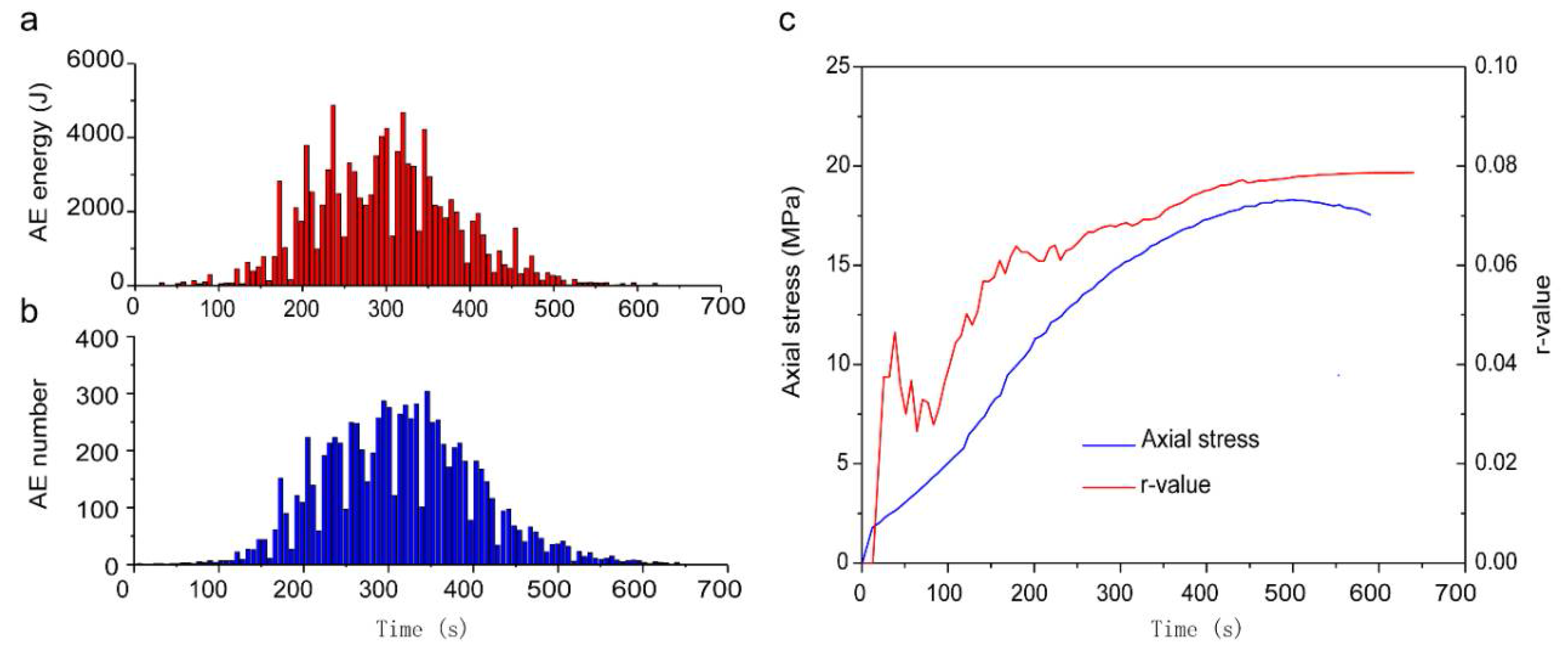
| Sample Number | Uniaxial Compression Strength/MPa | Damage Strength/% | Dilatancy Dtrength/% |
|---|---|---|---|
| SA-1 | 19.5 | 42.5 | 62.6 |
| SA-2 | 16.4 | 45.0 | 66.4 |
| SA-3 | 18.2 | 49.7 | 63.1 |
| Mean value | 18.0 | 45.7 | 64.0 |
| Standard deviation | 1.56 | 3.66 | 2.04 |
| Sample Number | AE Event Percentage/% | Event Sum | ||||
|---|---|---|---|---|---|---|
| Stage 1 | Stage 2 | Stage 3 | Stage 4 | Stage 5 | ||
| 1 | 0.06 | 3.04 | 14.4 | 71.9 | 10.6 | 6904 |
| 2 | 0.05 | 2.21 | 11.9 | 79.4 | 6.4 | 7751 |
| 3 | 0.02 | 2.74 | 15.1 | 74.5 | 7.6 | 8233 |
| Mean value | 0.04 | 2.66 | 13.8 | 75.27 | 8.23 | 7629 |
| Standard deviation | 0.02 | 0.42 | 1.68 | 3.81 | 2.16 | 673 |
© 2018 by the authors. Licensee MDPI, Basel, Switzerland. This article is an open access article distributed under the terms and conditions of the Creative Commons Attribution (CC BY) license (http://creativecommons.org/licenses/by/4.0/).
Share and Cite
Li, H.; Dong, Z.; Yang, Y.; Liu, B.; Chen, M.; Jing, W. Experimental Study of Damage Development in Salt Rock under Uniaxial Stress Using Ultrasonic Velocity and Acoustic Emissions. Appl. Sci. 2018, 8, 553. https://doi.org/10.3390/app8040553
Li H, Dong Z, Yang Y, Liu B, Chen M, Jing W. Experimental Study of Damage Development in Salt Rock under Uniaxial Stress Using Ultrasonic Velocity and Acoustic Emissions. Applied Sciences. 2018; 8(4):553. https://doi.org/10.3390/app8040553
Chicago/Turabian StyleLi, Haoran, Zhikai Dong, Yun Yang, Bo Liu, Mingyi Chen, and Wenjun Jing. 2018. "Experimental Study of Damage Development in Salt Rock under Uniaxial Stress Using Ultrasonic Velocity and Acoustic Emissions" Applied Sciences 8, no. 4: 553. https://doi.org/10.3390/app8040553




